Video transcoding is a huge space. We covered the Google VCU Video Coding Unit A few times. Xilinx, now AMD has been popular with services like Twitch in the past. With so much Internet traffic being video, there is a huge opportunity to improve codecs and lower bandwidth demands. Further, the number of real-time streams is increasing with streaming from PCs and mobile devices becoming mainstream. The AMD Alveo MA35D is AMD’s new custom silicon solution for video transcoding.
AMD Alveo MA35D Custom Silicon for Video Transcoding
The AMD Alveo MA35D is part of the company’s media accelerator line “MA”. This is the start of what will be a line for AMD, not just a single-card solution. Today’s card has two chips on a single low profile card and a $1595 MSRP.
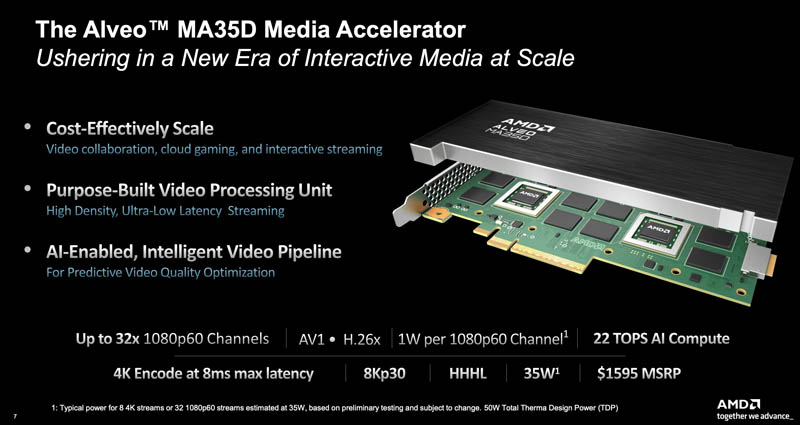
We asked about that connector on the back edge of the card and were told it is a debug connector that may not make it to the final version, but it is in the renderings.
On a generational basis, this new MA35D is the update to the AMD Xilinx Alveo U30. This accelerator uses hardened logic and achieves significantly more performance.
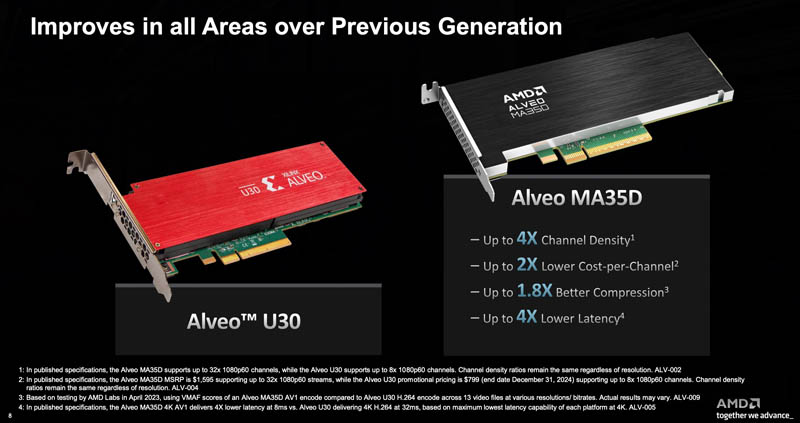
Here is the 5nm ASIC. The Alveo MA35D supports AV1, VP9, h265, and h264 and up to 8K resolution. Something that is different with the ASIC is that the VQ QoE Engine and VQ look-ahead features can, at low latency, make determinations of quality/ compression impacts and optimize streams in almost realtime.
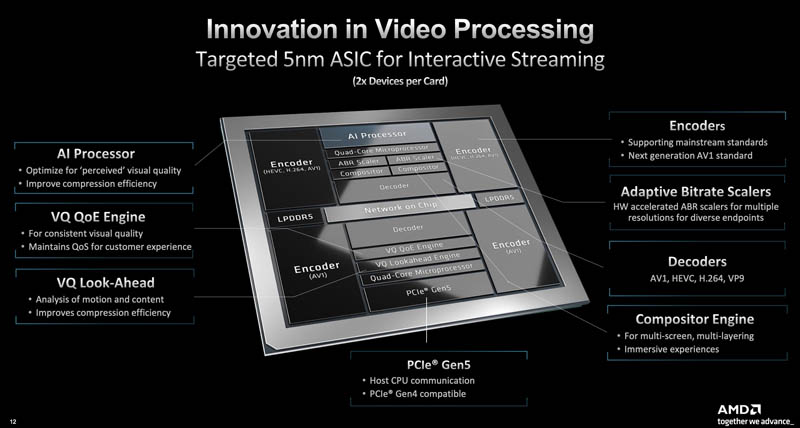
On the codec side, AMD is not only supporting AV1, but is new codec improvements help increase compression thus lowering bandwidth of streams.
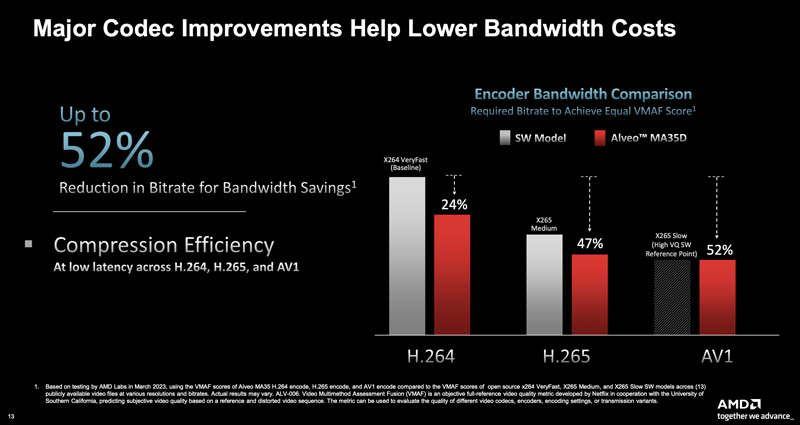
Since the Alveo line comes from the Xilinx acquisition, the Alveo MA35D has AI inference blocks as well. AMD showed an example of AI inference recognizing faces as important parts of streams and therefore prioritizing quality in that part of the frame.
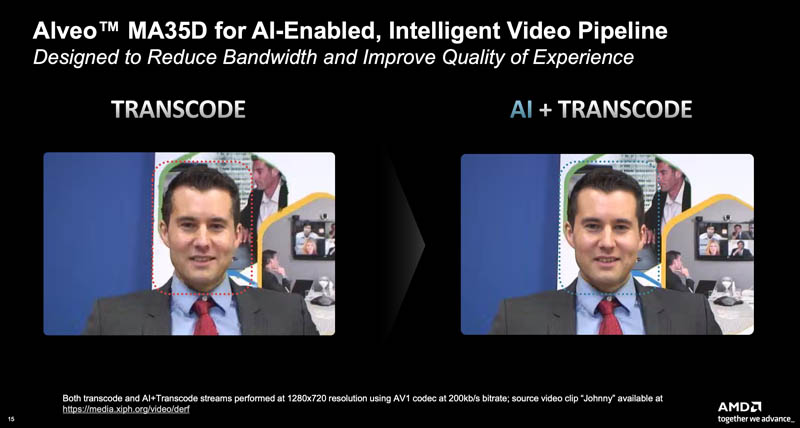
Here is AMD’s slide showing the pipeline to help reduce bitrate and bandwidth with the new cards that can handle 1080p60 streams at 1W.
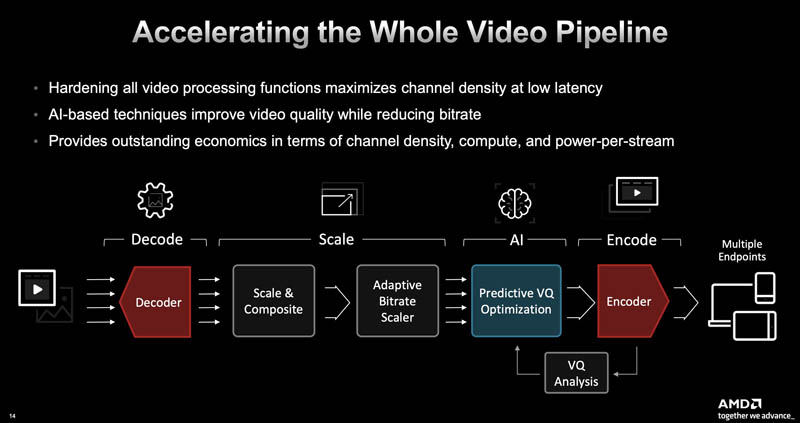
One of the more interesting slides is this one. AMD’s approach is to enable not just CPU transcode for higher-end streams (e.g. the Super Bowl), but also lower $/stream applications. While the hardware cost and power cost may not be large in the context of the Super Bowl, it is in terms of the Twitch streamer that is just starting out.
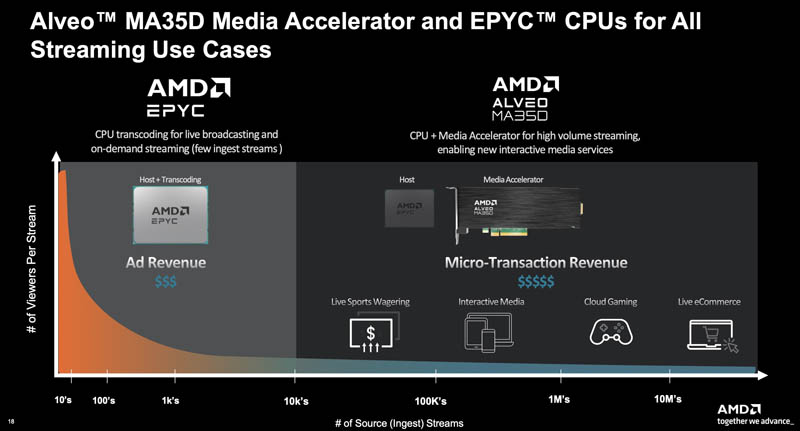
Aside from lowering costs per stream, the other goal of the MA35D is to help layer value-added services for ads and micro-transactions on streams with its partners.
Final Words
We asked AMD and this is not the type of card meant to be purchased one or two at a time. Instead, this is meant to be sold to AMD’s large streaming partners. Much of today’s transcoding happens when a GPU is used just for their video codecs. AMD is looking to make this much more efficient.

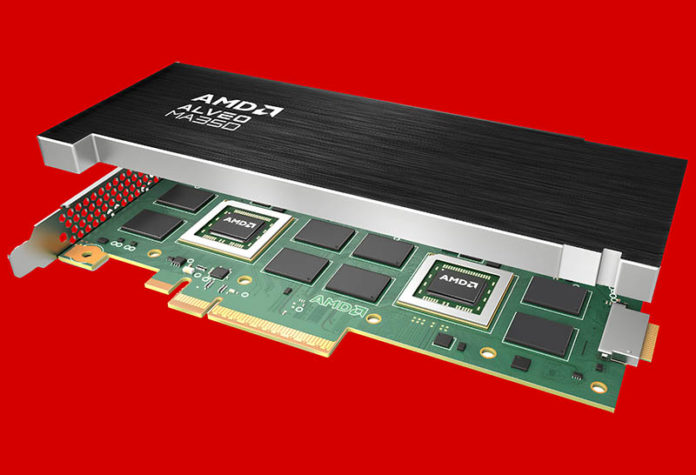



you know there’s still going to be a bunch of Plex users that will want one of these at home.
I wish that AMD would also release a “Junior” version of such a card for content creators who would like to stream to many platforms at once, without requiring 2 PC’s
That last slide is painfully dystopic, ad revenue is not enough so micro-transactions in interactive media is the new future.
Would love an NVEnc card.
Sell it to streamers, Plex users, self hosted cloud gaming enthusiasts and workstation users who want super low latency in a single slot card.
People in the comment section don’t seem to understand what this card is for.
Streaming to multiple platforms as a streamer still requires only one encoder unit since you are encoding a single stream and multicast that
Multipc setup is still recommended since if your gaming pc crashes, your stream won’t crash and the site won’t throw your viewers to a different page where they would have to click back to get back to you when your pc revives
Self hosted cloud gaming enthusiasts don’t need this card since you would need 30 gpus behind this card to actually render it the frames and then this card would encode those 30 gpu outputs to send it over the network which is not practical in any way, only lowend gpus don’t have encoder units on their own dies like the Nvidia GT series and lowend RX 6400-6500s. Last time I checked used GTX 1060s are just about everywhere for almost the same price as these encoderless cards but building out a cloud gaming setup from tons of cards like these would balloon platform costs like crazy (even if it sounds like a fun challenge) so you would be better off with a used enterprise nvidia card that has more encoders and can render out multiple streams of frames without hogging 40 pcie lanes
Dion, that last slide does not mean what you think it is. It means that dedicated streamers can make enough money for the streaming platform that they can justify more expensive CPU encoding. This encoder card basically enables lower return crapstreams that would have been too expensive to encode on cpu, it does not mean your fav streamers and streaming sites will have to paddle microtransactions
“Streaming to multiple platforms as a streamer still requires only one encoder unit since you are encoding a single stream and multicast that”
Yes you can do that but may not want to. Different platforms have different ingest limits in terms of max. bitrate, allowed codecs, framerates, resolutions, VBV settings, etc.
Someone might stream 4k60 H265 to Youtube at 40 Mbps via HLS, and also 1080p60 H264 at 6 Mbps to Twitch via RMTP. IDK about Facebook, and the rest of the platforms but I am sure they all have their own set of min/max requirements.
If someone just multicasts the same video stream to multiple platforms it will need to be the least common denominator, and quality suffers on platforms that would support better.
“The Video Encoding Card of my DREAMS – EXCLUSIVE SAMPLES!”
https://youtu.be/TYOkJFOL5jY
Adam over at EposVox believes this card is going to be a game changer. Well worth watching as Adam really gives a good rundown on how this card will change the encode/decode industry.
Are there any indications what drivers will be released with it? For example are we likely to see Vulkan Linux drivers?